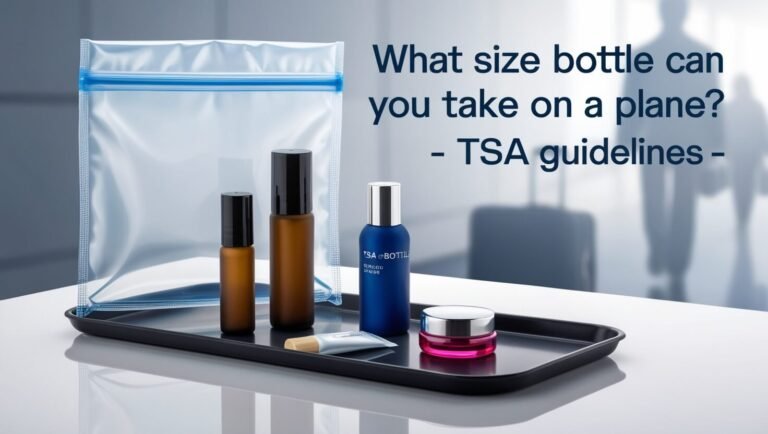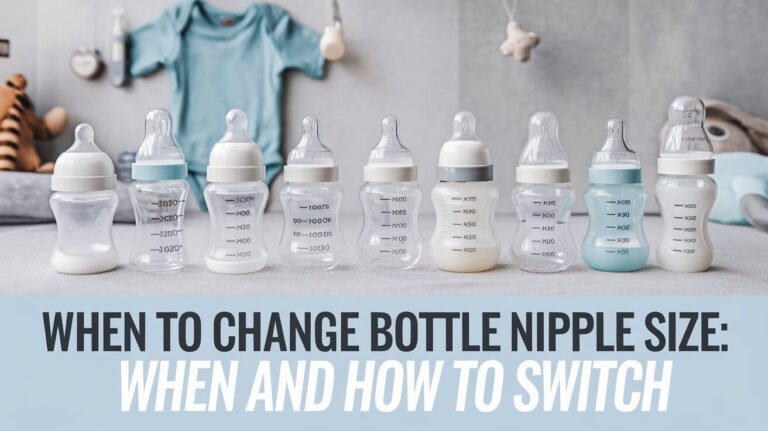What Size Bottle for Newborn: Choosing the Right Fit

Choosing the right bottle size for your newborn is a big decision. There are many bottle nipple levels and flow rates to consider. This guide will help you pick the perfect bottle size for your baby’s needs.
Did you know the bottle nipple size and flow rate matter a lot? They can make feeding comfortable and efficient. They also help prevent gas and spit-up. So, what size bottle is best for your baby?
What Size Bottle for Newborn: Essential Bottle Sizes for Your Baby
Choosing the right bottle size for your newborn is key for comfortable feeding. Newborns feed 8-12 times in 24 hours. For bottle feeding only, start with 4-6 bottles and teats.
Standard Bottle Capacity for Different Age Groups
For newborns up to 3 months, 4-ounce bottles are best. They help control how much your baby eats. When your baby gets older, 8-ounce bottles are better. They hold more milk for bigger feedings.
About 60% of parents use both 4-ounce and 8-ounce bottles. This helps meet their baby’s changing needs.
Factors Influencing Bottle Size Selection
Many things affect bottle size choice. These include how often your baby eats, their age, and how hungry they are. On average, a baby drinks 25-30 ounces of milk daily. This helps parents pick the right bottle size.
Signs Your Baby Needs a Different Bottle Size
- Sucking fiercely on the bottle
- Appearing frustrated during feeding
- Longer feeding times
- Falling asleep at the bottle
- Tugging on the nipple
Too-slow nipples lead to small, frequent feedings. Too-fast nipples cause milk spillage, gagging, spitting up, or tummy troubles. Watching for these signs helps parents know when to switch bottle sizes or flow rates.
| Bottle Size | Recommended Age | Prevalence among Parents | Typical Daily Milk Consumption |
|---|---|---|---|
| 4-ounce | Up to 3 months | 40% | 25-30 ounces |
| 8-ounce | Older than 3 months | 60% | 25-30 ounces |
Bottle Nipple Flow Rates and Their Impact
Choosing the right bottle nipple flow rate is key for your baby’s comfort and feeding. Flow rates can range from very slow to very fast. If it’s too slow, your baby might get frustrated. If it’s too fast, they could struggle and even get reflux.
Bottle brands use terms like “preemie,” “slow,” “medium,” or “fast” to show the flow rate. They might also use numbers like 0, 1, 2, or 3. But, every baby is different, and what’s recommended might not always be best. For example, breastfed babies might do better with slower nipples to match the natural flow of milk.
Signs your baby might need a faster flow include longer feeding times and fussiness. Watching how your child feeds and responding to their needs is important. This way, they can enjoy a comfortable and satisfying bottle-feeding experience.
| Bottle Nipple Brand | Flow Rate (mL/min) | Coefficient of Variation |
|---|---|---|
| Avent Natural Newborn Flow | 1.68 | 0.03 |
| Dr. Brown’s Standard Y-cut | 85.34 | 0.37 |
| Born Free Classic Level 1 | 9.40 | 0.28 |
| Medela CalmaWide Base Slow Flow | 24.74 | 0.27 |
| Playtex VentAire Wide Slow Flow | 4.90 | 0.35 |
| Tommee Tippee Feeding Bottle Slow Flow | 8.57 | 0.03 |
Best Bottle Features for Comfortable Feeding
Choosing the right bottle is key for your baby’s comfort and your peace of mind. Look for anti-colic properties and material safety standards. These features are important when picking the best bottle for your little one.
Anti-Colic Properties and Ventilation Systems
Babies with colic can greatly benefit from bottles that help reduce air intake. Search for bottles with anti-colic valves to prevent too much air from being swallowed. Some bottles also have vented wands for extra support against colic.
Material Types and Safety Standards
The material of the bottle is also crucial. Many parents prefer bottles that feel like a human nipple, like those made of silicone. Glass bottles are also popular because they’re durable and don’t contain harmful chemicals like BPA. Always check for signs of wear and make sure all parts fit together right to avoid leaks.
| Bottle Type | Overall Score | Leakage | Nipple | Ease of Cleaning | Eco-Health | Available Sizes | Material | Weight |
|---|---|---|---|---|---|---|---|---|
| Comotomo | 84 | 9.0 | 9.0 | 8.0 | 7.0 | 5, 8 oz | Silicone | 3.7 oz |
| NUK Simply Natural Glass | 79 | 9.0 | 7.0 | 7.0 | 8.0 | 4, 8 oz | Borosilicate Glass (BPA-free) | 5.8 oz |
| Evenflo Vented + Glass | 60 | 7.0 | 5.0 | 5.0 | 7.0 | 4, 8 oz | Tempered Glass | 4.9 oz |
| Boon Nursh | 73 | 8.0 | 7.0 | 7.0 | 7.0 | 4, 8 oz | Silicone, Plastic | 3.2 oz |
Focus on anti-colic properties and material safety to find the best bottle for your newborn. This ensures their feeding is comfortable and stress-free.
Common Feeding Challenges with Bottle Sizes
Parents of newborns often face challenges with bottle feeding. One big worry is nipple confusion. This happens when breastfed babies start using bottles. To avoid this, start with “level one” nipples, no matter the baby’s age.
Another issue is when babies stop nursing after getting used to bottles. Some may not move to bigger nipples. Others might need a bigger nipple if the nursing parent has a fast letdown. Look out for signs like gulping, choking, or refusing to eat.
| Feeding Challenge | Potential Causes | Signs to Look For |
|---|---|---|
| Nipple Confusion | Introducing bottles to breastfed babies | Refusing to nurse, difficulty latching |
| Bottle Preference | Bottle feeding becoming easier than nursing | Refusing to nurse after bottle use |
| Flow Rate Issues | Mismatched nipple size or flow rate | Gulping, choking, hard swallowing, coughing, increased drooling, refusing to eat |
Choosing the right bottle size and flow rate is key. Watch your baby’s feeding cues closely. This way, you can make bottle feeding a smooth and comfortable experience for them.
Bottle Sizing for Combination Feeding
Feeding your baby a mix of breast milk and formula requires the right bottle size and flow. Start with bottle nipples that have a slow flow, matching the natural flow of breastfeeding.
Transitioning Between Breast and Bottle
It’s important to use “level one” or “slow flow” nipples when switching between breast and bottle. This helps avoid nipple confusion and makes the transition easier for your baby.
Flow Rate Adjustments for Mixed Feeding
As your baby grows, you might need to change the bottle nipple’s flow rate. Look for signs that the flow is too slow or too fast. Adjust it as needed. Some breastfed babies might not need to change, while others might, based on the parent’s milk flow.
The recommended bottle size for infants and standard bottle size newborns can differ. It’s crucial to listen to your baby’s cues and adjust the baby bottle sizes newborn as necessary.
Signs to Change Bottle Size or Flow Rate
As your baby grows, their feeding needs change. You might need to switch to a different bottle size or flow rate. Look for signs like longer feeding times, tugging at the teat, or falling asleep while feeding.
Other signs include gulping, coughing, gagging, or excess milk dripping. If your baby refuses to feed, it’s time for a change too.
Parents should watch their baby’s feeding habits closely. Bottle teats should be replaced every two months or sooner if damaged. The flow rate also needs to adjust as your baby grows.
Remember, the right bottle size and flow rate change as your baby gets older. By paying attention to your baby’s cues, you can help them have a comfortable and efficient feeding experience.
Amazing Questions:
What are the standard bottle sizes for newborns?
Newborns usually do well with slow flow teats in their first few months. The standard sizes for newborns are 4-6 oz (120-180 ml).
What factors influence the right bottle size for my newborn?
Several factors affect the right bottle size for your newborn. These include how often they eat, their age, and how hungry they are. Signs they might need a different size include sucking hard, looking frustrated, feeding for a long time, falling asleep while feeding, or pulling on the nipple.
How do I choose the right nipple flow rate for my newborn?
Choosing the right flow rate is key for comfortable feeding. If the flow is too slow, babies might work too hard. If it’s too fast, they might struggle. Most bottles have labels like ‘preemie,’ ‘slow,’ ‘medium,’ or ‘fast’ to show the flow rate.
What features should I look for in a bottle to reduce feeding discomfort?
Look for anti-colic bottles to help with feeding comfort. These bottles have special valves to reduce air and help with colic. Some also have vented wands for extra support.
What are some common feeding challenges related to bottle sizes?
Some common challenges include nipple confusion in breastfed babies. To avoid this, start with ‘level one’ nipples, no matter the age. Another challenge is babies not wanting to nurse if bottle feeding is easier.
How do I choose the right bottle size and flow rate for combination feeding?
For combination feeding, use slower-flowing nipples to match breastfeeding. Start with ‘level one’ nipples to avoid nipple confusion. Adjust the flow rate based on your baby’s cues.
How do I know when to change my baby’s bottle size or flow rate?
Signs it’s time to change include longer feeding times (over 20 minutes), tugging at the teat, falling asleep while feeding, gulping, coughing, gagging, excess milk dripping, or refusing to feed. Watch your baby’s feeding behavior and adjust as needed.




